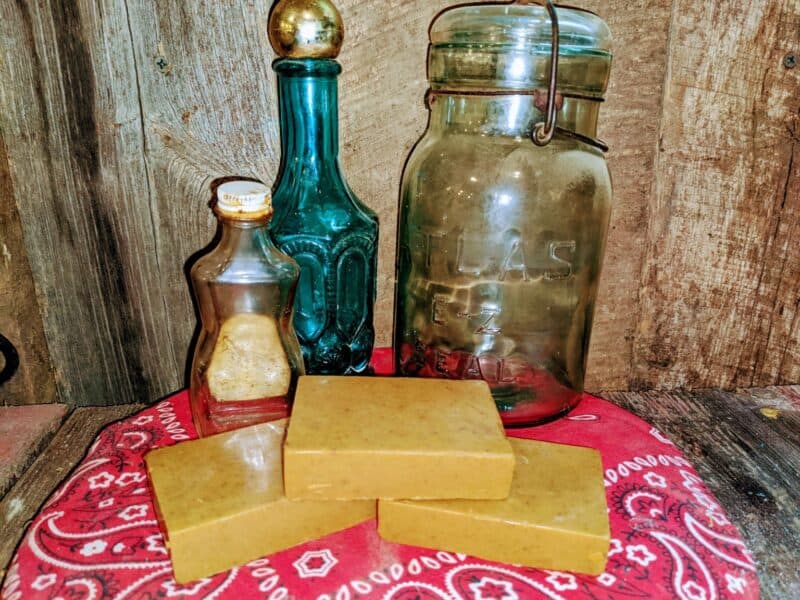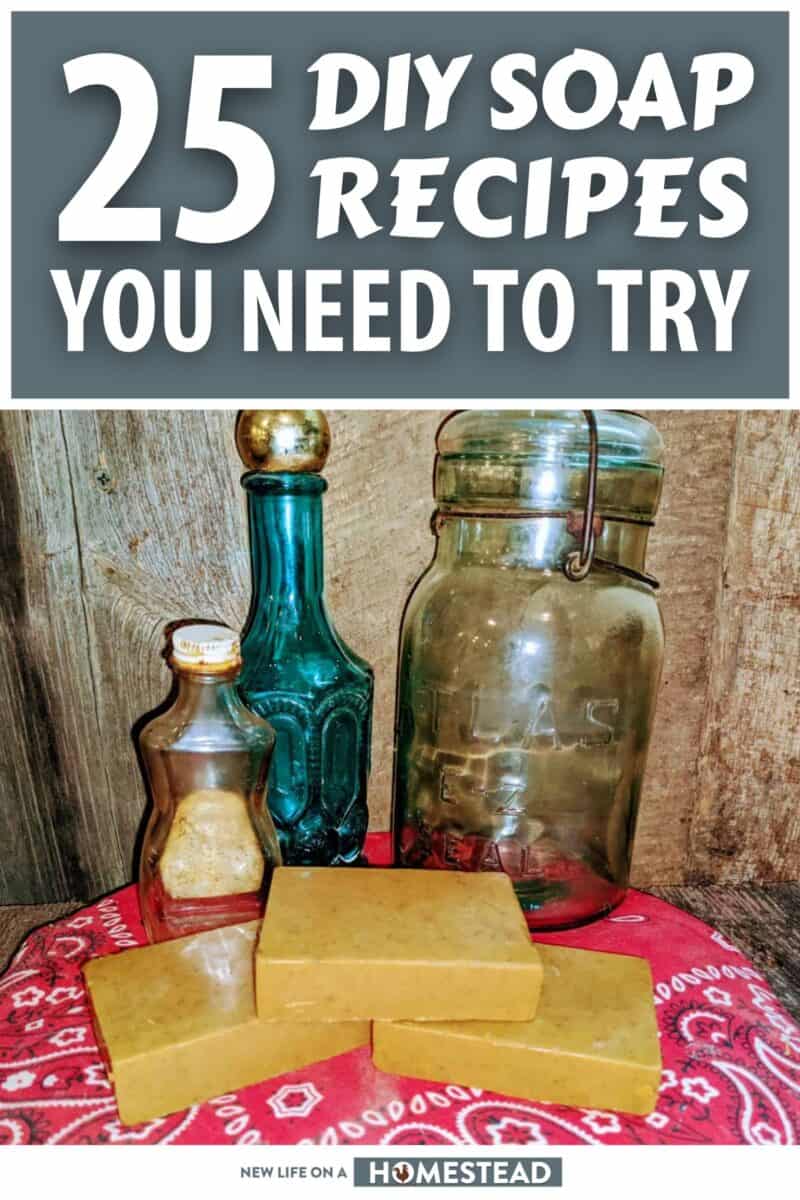Making soap is a fun and rewarding way to create your own natural, personalized soap at home. Homemade soap recipes are often more cost-effective than store-bought options, and they also allow you to control the ingredients and customize the scent and texture to your liking.

So, how do you avoid running out of soap? Well, you make it yourself. It’s not too hard, and if you do it right it’ll give you a neat little side income.
With that in mind, let’s have a look at a few DIY soap recipes that you can make at home.
Soapmaking Methods
You can’t make soap without at least being a little knowledgeable about the different methods of soapmaking…well, technically you can but it’d be like jumping into the deep end of a pool to learn how to swim.
With that said, the four most common methods of soapmaking are:
- Melt and Pour
- Hot Process
- Cold Process
- Re-batching
Melt and pour is the easiest (and probably the safest) method of soapmaking. All you do is cut down a soap base (either goat’s milk, honey, oatmeal, shea butter, or natural glycerin) and melt it down.
You add whatever ingredients you want – scents, colors, etc. – and stick the mixture in a mold to dry and cure.
This method is great for those who have kids and/or don’t want to have direct contact with lye (sodium hydroxide) because all the necessary chemicals – including the lye are already prepared in the soap bases.
Hot process soapmaking involves mixing lye, oils, and other bits and bobs and heating the mixture in a slow cooker until it reaches saponification. From there, you pour it into a mold and leave it to set and cure.
Cold-process soapmaking is the same as hot-process soapmaking with the big difference being that you mix the oils and lye solution separately and combine them later.
Re-batching is…well…reusing a batch of soap. You’ve made a batch of soap, and it didn’t come out the way you wanted it, so you melt it down and do it again. This saves you the time and trouble of starting from scratch.
A Word of Caution Before We Start
Before we get to the list, be very careful while making this stuff!
A crucial ingredient in soapmaking is lye. Lye is highly caustic and will do serious damage to your skin and/or eyes.
With that in mind, keep it properly stored and away from your kids and pets. Make sure you have all the requisite safety gear – gloves, glasses, etc. – before you start.
1. Vanilla
Vanilla is a popular scent, it’s light, fragrant, and comforting. If you don’t go overboard with the essential oils, the scent isn’t overpowering. This is a personal favorite of mine.
A good vanilla soap recipe can be found here. The best thing about vanilla is its versatility. You can mix it with pretty much anything.
2. Shea Butter and Rose
My mom’s favorite flowers are roses, and I understand why. The sweet, light scent is refreshing without being overpowering.
When you mix it with creamy shea butter and vanilla, you get a great moisturizing soap.
If you’d prefer something a little more…fruity…then try adding cranberries to your vanilla and shea butter instead of rose.
3. Aloe Vera and Dried Nettle Leaves
A well-known medicinal plant, aloe vera can be used to treat a couple of different things.
This one uses a glycerin base and dried nettle leaves for a soothing soap with a nice texture. You can get a recipe here.
4. Beeswax
Beeswax has a variety of moisturizing properties which makes it ideal for soapmaking.
With that said, this recipe uses the hot process to give you a nice moisturizing soap that is soft on your skin. You can use this recipe to make your own beeswax soap.
5. Coffee
I’m one of those people who can’t do anything without a cup of coffee in the mornings. Of course, drinking too much coffee is a very bad idea – especially if you don’t handle caffeine well.
So, how do you get around that problem? Well, you could try a coffee soap.
Simply add a touch of coffee to a goat’s milk or shea butter soap base and you’ll get a creamy soap with a nice scent. You can get a recipe here.
6. Rosemary and Lavender
A soothing, anti-bacterial scent, lavender is a very relaxing and soothing scent that is popular worldwide.
Lavender can be blended with just about anything which makes it a very versatile scent to use. You can get a nice recipe here.
7. Tea Tree
Tea tree oil is commonly used in aromatherapy, candle making, and, of course, soapmaking.
It’s typically used as a base oil for mixtures with peppermint or eucalyptus because of its strong scent.
Tea tree is a scent that you need to be careful with because if you overdo it, it’ll be overpowering. It’s very versatile and you can get a good recipe here.
8. Honey
Apart from being aesthetically pleasing, honey has a couple of different uses – including soothing an irritated throat. Honey soaps are fairly easy to make, and you can get a good recipe here.
9. Peaches and Cream
This one’s pretty simple, a goat’s milk base with a bit of peach scent, and voila! You have peaches and cream.
It looks nice, it smells nice, and your skin will certainly thank you for using it. You can get the recipe here.
10. Marbled Beer
This is probably the most interesting soap on this list – probably the prettiest too.
The basic idea is that you add evaporated beer to the soap mixture, and it gives a nice textured look to the soap. It’s very cool and I highly recommend trying it. Here’s the recipe.
11. Peppermint and Shea Butter
Okay, so we know how irritating bug bites can be. That said, however, peppermint can be used to treat the irritation caused by bug bites.
You can also use shea butter to give you a creamy soap that can treat bug bites. Sounds good to me, so get a recipe here.
12. Thai Tea
So, Thai tea soaps have traces of sugar, tea, and coconut. This one has a nice color to it, and the streaks of white give it that touch of wow factor. It smells great and feels great on your skin. Try it yourself, here’s the recipe for you.
13. Coconut and Shea Butter
I’ve talked about shea butter a few times now because it’s so good. The mixture of shea butter with coconut essence gives you a moisturizing soap with a creamy texture and a tropical scent. You can get a nice recipe here.
14. Pumpkin Spice and Cinnamon Goat’s Milk Soap Recipe
If you’ve got very sensitive skin or you have kids with very sensitive skin, then this might be a good soap to try.
Goat’s milk is well-known for its moisturizing qualities which makes it a popular ingredient in soapmaking.
This particular soap is creamy and soft on your skin, so if that’s something you need, here’s our pumpkin-spiced soap recipe.
15. Goat’s Milk and Honey
A combination of the creamy, moisturizing qualities of goat’s milk and the natural anti-bacterial qualities of honey, this one will smell great and be gentle on your skin.
If this sounds like something you’d like to try, you can use this recipe.
16. Rose Clay and Charcoal
I’ve occasionally dealt with oily skin and it’s never fun. It would’ve been better if I’d known about this soap. The rose clay and charcoal are both well-known for their oil absorption properties.
This soap is gentle on the skin, and it has a very pleasant rustic look and scent. You can use this recipe to make your own soap.
17. Basil Soap
This is exactly what it sounds like, a soap with basil – both the herb and the essence. The combination of shea butter, coconut, avocado, olive, and castor oil makes a soap that’s soft and moisturizing on the skin. You use this recipe to make your own.
18. Poppy Seed
This one is a soft, moisturizing soap with poppy seeds providing a natural exfoliate. The use of a shea butter base provides a creamy texture.
If you need an exfoliating soap, this may be the one for you. Try this recipe for yourself.
19. Yogurt
Yogurt has a few different medicinal uses – to treat acne, for example. It also has softer, exfoliate than most store-bought exfoliates.
The high-fat content helps to moisturize the skin. If you’d like to try this yourself, you can use this recipe.
20. Rosemary, Lemongrass, and Peppermint Herbal Soap
Herbal soaps are very popular because they look and smell great, and some have certain medicinal properties.
Lemongrass, peppermint, and rosemary are all nice scents, but you will have to be careful – especially with the lemongrass – that you don’t overdo it with the essential oils.
If you get it right, you’ll have a nice-smelling, gentle soap. Here’s a recipe for you.
21. Coconut Oil and Annatto Seeds
Coconut oil is very useful and versatile, it can also be very expensive which is unfortunate because it makes a great moisturizer. It’s a great hydrator and cleanser and the annatto seeds make a nice exfoliate.
The bergamot essential oil adds a light, citrusy smell which is pleasant to the senses. If you want to make this yourself, here’s the recipe.
22. Charcoal
This is probably not the most budget-friendly soap to make, but it’s great for your skin.
The charcoal draws the dirt, chemicals, and other nasties to the surface of your skin making it easier to remove them.
Obviously, removing the unhealthy stuff from your skin is a good thing and you can do it yourself with this recipe here.
23. Grapefruit and Himalayan Salt
Grapefruit is readily available at most grocers and not horribly expensive. The fruit has numerous vitamins and minerals which are good for your skin.
Adding Himalayan salt makes a great natural exfoliating soap. Here’s the recipe if you want to try it yourself.
24. Oatmeal and Cinnamon
Oatmeal has great exfoliating properties and is soothing on the skin. Cinnamon has strong antioxidants to clear your skin of any problems. If that’s something you need, here’s the recipe for you.
25. Bergamot and Earl Grey
Earl Grey is a personal favorite tea of mine, but it is, admittedly, an acquired taste. Bergamot is a nice citrus scent that is light and refreshing. This is an all-natural soap that will please your senses. You can get the recipe here.
Happy Soaping!
Soapmaking is a fun hobby to have and doing it well can, as I said earlier, give you a neat little side income.
That said, you do need to be careful when you’re working on a batch – especially if you have kids. Not all of these methods are kid-friendly, and I doubt you’d like your little ones to accidentally spill sodium hydroxide on themselves.
With that in mind, just make sure that you take all the needed safety precautions, and you should be just fine.
It’s a bit daunting at first, but once you’ve gotten the hang of it, you’ll have a useful new hobby to enjoy and you’ll save some pretty serious money in the long run.
Store-bought soap is cheaper to get, but not if you have to replace it every few weeks. Imagine not having to buy soap for months on end; if that’s not motivation I don’t know what is.
Something to keep in mind, though, is that prices of tools and ingredients will vary between suppliers with some places being more expensive than others.
With that in mind, go easy on your wallet – poor guy’s got enough to worry about.
As always, I hope you guys and gals enjoyed the article and that you found it helpful. Thanks for reading and I’ll see you for the next one!


Greg is a South African farmer and homesteader who’s been around animals ever since he can remember. He’s also an avid camper and hiker.
